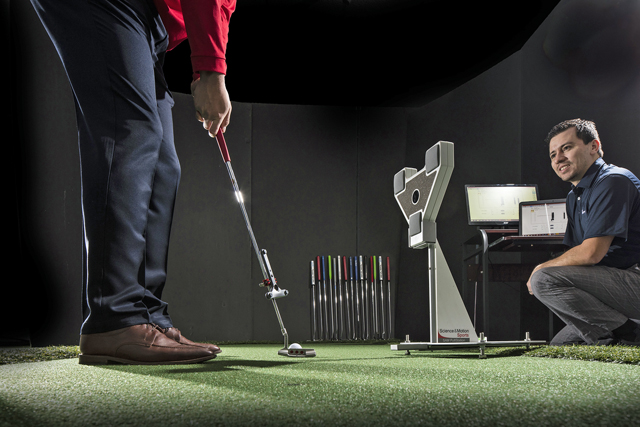
Everyone knows if it “looks good” that’s about as far as you need to go finding the right putter. Oh sure, shaft length depends on how much you bend from the waist and how your arms hang but that’s about it.
Well, that’s not only wrong but finding the correct putter takes a lot more analysis by taking into account the loft at address and impact, the amount of rotation in the stroke, alignment and several other factors. The idea is to find a putter that best matches your natural stroke.
A good way to say it is, match the putter to your stroke not change your stroke to match the putter.
A recent visit to Club Champion, the national chain of fitting centers proved this beyond any doubt. I met with Jesse Smith, a master fitter in the Orlando Club Champion location and he put me through a session that changed the way I think about both my putting stroke and the putter I use.
First, Smith had me hit seven 10 foot putts with my current putter, a 35 inch modern-style blade—4 degrees loft, 45 degrees of toe hang, one shaft width of offset and regular size grip. Then we experimented with several different putters changing shape, grip and other specs and settled on one of the same length and offset but a face balanced mid-mallet with only 2.5 degrees loft and a medium diameter oversize grip.
It made a huge difference. No longer did a feel as though I was “fighting” my stroke. Everything having just seemed simpler from aiming to distance control.
Coincidentally, among the three dozen or so previously-loved flat sticks in my garage was a face balanced mallet of the right length so all it needed was to be bent to 2.5-degrees and have the larger grip installed to be put in play. Happily I can report my putting has improved. Essentially three-putts are a thing of the past and there’s a lot more confidence on those ones in the “throw-up zone.”
After the session, which costs $100, Smith answered some questions about the process and how he fits golfers with a putter that allows them to use their natural stroke.
ET: Generally describe the process of putter fitting – the machine th at you use and what are the things you look for?
at you use and what are the things you look for?
Smith: “Club champion utilizes the technology of Science and Motion PuttLab (SAM for short) to go through the putter fitting process. We start with the customer’s existing putter and take measurements of loft, lie, and length. Then the customer is run through the Science and Motion software, and a detailed report is generated based on the individuals putting mechanics and stroke. We look at many different parameters of the individuals putting stroke with emphasis on face at impact, both static and effective loft, lie angle, consistencies of rotation and timing, and club path. While selecting a putter for an individual the amount of toe-hang, weight, length, loft and lie, as well as swing weight are considerations based on the report the Science and Motion PuttLab generates.”
ET: Which of the factors is the most important?
Smith: “While all aspects of the customers putting stroke are a factor, putter face angle at impact is paramount, which accounts for 83% of overall ball direction.”
ET: You said typically your recommendations are for face balanced putters, why?
Smith: “While recommendations vary greatly as far as toe hang with each client, it seems that most individuals could benefit from reduced rotation of the putter face, which face balanced putters promote. Adding to that, most faced balanced putters are mallets, or have a fair amount of perimeter weight, which are most forgiving on off center hits, and all golfer can benefit from that.”
ET: Same question but concerning the amount of offset?
Smith: “Offset is there on a putter to help an individual aim correctly to what their own mind perceives as straight or on target. Depending on what the natural tendency is of each individual, the amount of offset can be increased or decreased based on putter head design depending on where they are consistently aiming the putter face at setup.”
ET: What is the significance of putter loft? Putter length? Grip size?
Smith: “With putter loft, there are actually two lofts on the putter face, Static loft and Effective loft. Static loft is the loft of the putter at address, and effective loft is the loft on the face at impact (often referred to dynamic loft). Golfers typically increase or decrease the amount of loft on the face by the time the putter face arrives to the ball, making the loft on the face at impact a crucial component of achieving the necessary effective loft on the face at impact. If a player sees a lot of ball skidding or inconsistencies in distance control, loft may be the culprit. Having the correct effective loft on the putter at impact will make for a truer, more consistent roll of the golf ball. Loft can also affect the way a putter sets up for an individual. Important to note as well is that too much loft and the putter can appear closed at address and too little loft and the putter can appear open.”
“Putter length is crucial to having the best chance of making your most consistent putting stroke. It has been shown that a golfer will putt on a more consistent path when putting down their peripheral vision line. Having the right length putter simply positions the golfer’s eyes over or slightly inside of the golf ball at the address position, giving the best opportunity for a consistent stroke. Too long or too short of a putter, can cause issues in path and consistency of the putting stroke. Furthermore, having the right length putter is critical for insuring centered face contact.”
Smith continued, “Choosing the proper grip size is also important as it is based on consistency of putter head rotation, and putter face at impact. If a grip is too small for an individual, they will have a tendency to release the putter face at impact excessively which can lead to a closed position at impact. Conversely, if a putter grip is too large, it can lead to leaving the putter face in an open position at impact. It is important to note that many customers react to weight, toe hang, and rotational properties different than others, which is to say that while people may not react the same to every changing parameter, SAM provides us an extremely solid guideline to make many crucial adjustments for a customer to putt to their fullest potential.”
So take Smith’s advice, match your putter to your stroke not the other way around.
